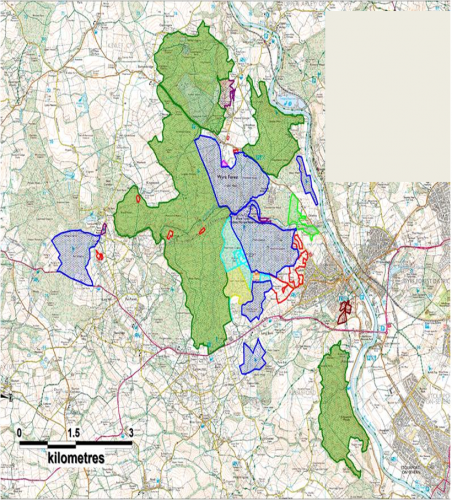Ref: CSFF070003
Lead: Jenny Joy, jjoy@butterfly-conservation.org
Group members: 10
Length of agreement: 5
Area of group (Hectares): 1878
The Wyre is a rich diverse area with many priority habitats including lowland heathland, traditional orchards and ancient and native woodland. Much of the area is SSSI supporting important populations of priority butterfly species (Pearl-bordered Fritillary, Small Pearl-bordered Fritillary and Wood White) and many priority woodland birds (e.g. Tree Pipit, Pied Flycatcher, Wood Warbler, Spotted Flycatcher and Marsh Tit).
Farmers participating in The (Mid Worcester) Wild Pollinator project will deliver: The Wild Pollinator and Farm Wildlife Package: Westgrow Ltd growers are reliant on pollinators for the success of their fruit crops and with farmers in the wider catchment will work to increase opportunities for Wild Pollinators in such a way that will also be of benefit to the farmer.
Will build on existing habitat maps (e.g. FER/FEP maps) and identify opportunities for connectivity and enhancement and will include options such as sowing nectar flower mixes, enhancing species diversity in existing grassland including existing buffer strips, year round food supply for insects and birds, shelter and nest sites .
To identify the potential for funding streams e.g. Capital Works for hedges, Woodland Creation and Management Grants . Evaluating the status of current Agri-environment schemes will identify opportunity for adjustments and future applications as individuals/a group to the Mid and Higher tier applications
Water Quality
Building on existing relationships and working with land managers in the broader catchment to create active Integrated Pest Management (IPM) Plans with cost benefit analyses which will be shared at training events. Identify the potential for ’STEPS’ (Severn Trent Environmental Protection Scheme) currently under development and eligible farmers can claim up to £5000 to make improvements to protect water.
Landscape
Assessment of hedgerow species diversity and quality of management, trees in hedgerows both from a landscape value and biodiversity value. Multiple benefit: delivering multi-functional solutions e.g. nectar mixes increasing the amount and duration of nectar availability to wild pollinators whilst also buffering the Brook , connecting habitats , reducing the need to import pollinators, increasing local knowledge and engagement of locals with solutions, improving the catchments resilience to climate change. (e.g. flash flooding, water logging, drought)

